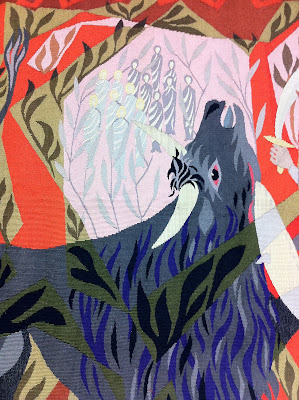The story of Theseus and the Minotaur can be found in Plutarch's The Rise and Fall of Athens. Theseus was the illegitimate son of Aegeus, ruler of Athens. Athens had been defeated by Minos of Crete and every nine years Athens was ordered to pay tribute in the form of seven young men and seven young women (anybody spotting the inspiration for The Hunger Games?). On their arrival on Crete, the youths were sent into a labyrinth which was inhabited by the Minotaur a vicious beast half-man half-bull. When Theseus first arrived in Athens (as a young man) tribute was due and he volunteered to go. Though Plutarch wrote that the details of the story differ from author to author, it is said that Theseus defeated and killed the Minotaur and led the other 13 tributes back to Athens safely.
 |
| Le Minotaure (1928) Pablo Picasso, black chalk and paper on canvas, National Museum of Modern Art, Pompidou Centre, Paris. Donated by Marie Cuttoli 1963. |
The minotaur first features in a twentieth century tapestry in 1935. Marie Cuttoli owned a picture by Picasso of Le Minotaure and commissioned a tapestry of it from an Aubusson workshop. Picasso's image does not reflect a specific point in the story of the minotaur. The artist visited the subject of the minotaur repeatedly in his prints and drawings; this particular image is thought to be the first and is concerned with the grotesque combination of bull and man. It is an uneasy image, as if the legs of the man are struggling to escape from the head of the bull. It is an unlikely image for tapestry: it has a plain background and the central figure is executed as a line drawing.
 |
| Theseus and the Minotaur (1943-44) designed by Marc Saint-Saens, woven Aubusson, 284 x 478 cm, National Museum of Modern Art, Pompidou Centre, Paris |
The subject of the Minotaur appears again almost a decade later in a tapestry designed by Marc Saint-Saens. Saint-Saens chose to focus on the moment that the minotaur was killed by Theseus. It is a bloody image as theseus plunges his sword into the bull's neck. His treatment of the subject and its translation into tapestry is in keeping with French tapestries of this period. Saint-Saens and his colleagues (includign Jean Lurcat and Dom Roberts) employed bold bright colours and plentiful detail to create weavings that took advantage of the unique nature of tapestry. This is in contrast to the Picasso piece which is essentially a drawing enlarged and copied into tapestry. Interestingly, the Minotaur is no longer half-man but is all-bull. It is reminiscent of bull fights and we may think this was the tapestry's subject were it not for Theseus' ancient dress. Given the political situation in France at this time, it is not surprising that Saint-Saens chose to focus on the moment of the Minotaur's defeat. Theseus takes on the role of France overcoming the fascist occupation of the Nazis.
 |
| Theseus and the Minotaur (1956) designed by Sax Shaw, weavers unknown, woven at Dovecot Studios. |
 |
| detail of Theseus and the Minotaur |
A Dovecot tapestry of Theseus and the Minotaur was woven in 1956 and designed by Sax Shaw, then artistic director. Shaw was very influenced and inspired by French tapestry designers and often adopted their imagery. However, he used these images and motifs in very different ways. His version of Theseus is more simplified and less violent that Saint-Saens'. Theseus' arm is raised, about to strike. Movement is suggested by the swirling patterns of solid colour, typical of Shaw's design style. This work makes the most explicit reference to the story as 14 tributes can be seen in the background (though it really ought to be 13).
Topics like this are one of my favourite parts of research: selecting a particular theme, image or effect and tracing its origins and development in the woven medium. I'm sure there will be many more to come.
No comments:
Post a Comment